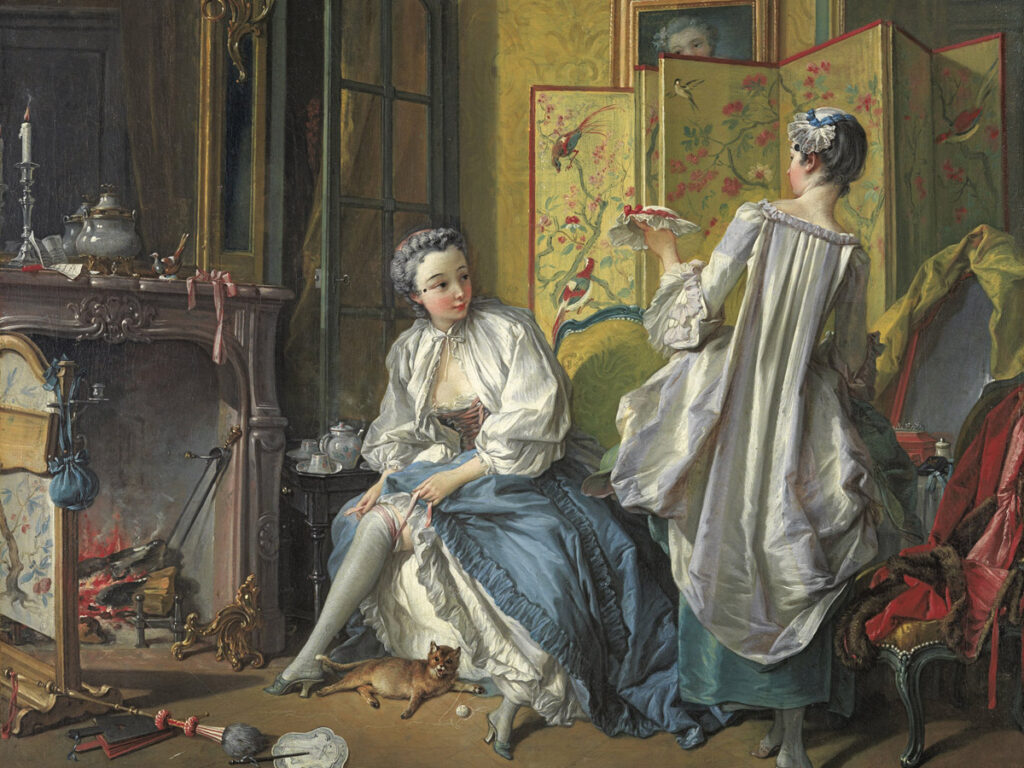
When homes were heated by burning logs, the fire screen was commonly placed in front of the fireplace to shield a room’s occupants from the excessive heat, glare and flying sparks of the fire.
Fire screens, originating in the Middle Ages, were a necessity when massive fireplaces were common and protection was needed. Over time, they have morphed from functional objects into wonderfully ornate works of art that could be the focal point of a room.

Fit for a king
There are few remaining traces of medieval fire screens, but it is believed that the earliest ones were made of wicker. The screens were often ornamented with needlework. English king Henry VIII is known to have received what must have been a highly elaborate example: a ‘great foulding skreene of seaven foulds, with a screen-cloth upon it, of green kersey’ (a coarse woollen cloth).
By the eighteenth century, screens of many kinds were available to people with the resources to buy them, often painted or decorated with needlework. Alongside folding screens, those with uprights and a central panel became popular – and were officially named during this time. Most screens were made of wood rather than metal, which became too hot. By the mid-1850s, when heating stoves were available to warm rooms, fire screens became more decorative than useful – and were frequently used in front of empty fireplaces.
The cheval screen
The cheval or horse screen, common from the eighteenth century onwards, is a large rectangular screen mounted on two feet on each side – hence the name. Placed in front of unused fireplaces, the screen improved a room’s appearance. Often decorated with embroidery, papier mâché, painted wood or stained glass; in some cases, the frame and feet were also carved, although usually the panel was the focus. Cheval screens were common in elegant Victorian interiors and suited to the eclectic late-nineteenth-century period, when Oriental-themed versions were made in brass and gilded wood.

The pole screen
This smaller, tray-like screen on a vertical pole mounted on a tripod was placed between a fire and the room’s occupant. Decorated with embroidery, banners, lacquer, cut paper or paint, it could be adjusted up or down to shield the face from the heat. This was a particular necessity in the seventeenth and eighteenth centuries, when both sexes turned to make-up to hide blemishes; those with smallpox wore thick cosmetics made of wax and white lead – a dangerous combination when hot. When the disease was no longer as prevalent, pole screens became smaller, available in many forms from oval to heart-shaped.

Hand-held screens
While in the late 1800s mounted standing screens were most common, in the first half of the century hand-held fire screens (from painted papier-mâché or metal) dominated. These were often used to show off the needlework or artistic skills of the women of the house – with sewing and painting then desirable attributes for middle- or upper-class women. Such screens had existed since the 1700s – as captured in the bottom-left corner of François Boucher’s 1742 painting ‘La Toilette’, below. These screens were used in a similar way to fans: the way that they were held could contain unspoken messages – for instance holding the screen to the right cheek meant ‘yes’, and to the left ‘no’.

The banner screen
Reminiscent of a pole screen but featuring a loose piece of silk or embroidery instead of a solid screen, the banner screen was weighted with tassels on its lower edge and supported at the top by a crossbar connected to a pole. The banner screen became popular in the early nineteenth century.
The three-panel screen, covering the fireplace almost completely, and with two side panels angled away from the middle one, was another style in what had become a wildly diverse industry. By 1881, an article in The Furniture Gazette captured the proliferation of screens available at the time:
Of the tribe of fire screens and draught screens there are so many varieties that it is impossible to mention more than a tithe. The purpose of the former is so apparent as to need little commendation. So long as we are scorched, baked or fried at one side of the room and frozen at the other so long shall we require at times a screen between the fire and those nearest it. This screen may take the form of transparent glass or tinted cathedral glass in leaded squares. It may have its panels of brocade, or old leather of rare needlework by skilful fingers, or of painting on panel in oils or in water colour.

P.S. if you are looking for something more modern, don’t miss our Emma Firescreen.
Made from powder-coated steel with elegant brass details, it was designed to look beautiful with or without a fire flickering behind it. Available in small and large versions it pairs perfectly with our Emma Companion Set of fireplace tools and Emma Basket.



